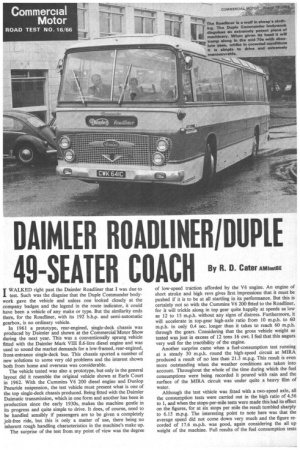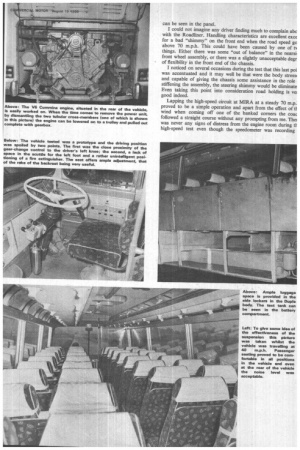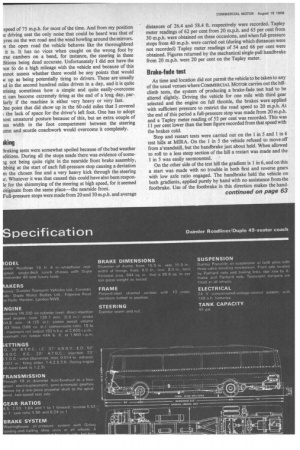DAIMLER ROADLINER/DUPLE 49-SEATER COACH BY R Cater AminstBE
Page 58

Page 59

Page 60

If you've noticed an error in this article please click here to report it so we can fix it.
IWALKED right past the Daimler Roadliner that I was due to 1 test. Such was the disguise that the Duple Commander bodywork gave the vehicle and unless one looked closely at the company badges and the legend in the route indicator, it could have been a vehicle of any make or type. But the similarity ends there, for the Roadliner, with its 192 b.h.p. and semi-automatic gearbox, is no ordinary vehicle.
In 1961 a prototype, rear-engined, single-deck chassis was produced by Daimler and shown at the Commercial Motor Show during the next year. This was a conventionally sprung vehicle fitted with the Daimler Mark VIII 8.6-litre diesel engine and was used to sound the market demands for a low-framed, rear-engined, front-entrance single-deck bus. This chassis sported a number of new solutions to some very old problems and the interest shown both from home and overseas was considerable.
The vehicle tested was also a prototype, but only in the general layout did it resemble the original vehicle shown at Earls Court in 1962. With the Cummins V6 200 diesel engine and Dunlop Pneuride suspension, the test vehicle must present what is one of the top single-deck chassis produced. Being fitted with the Daimler Daimatic transmission, which in one form and another has been in production since the early 1930s, makes the machine gentle in its progress and quite simple to drive. It does, of course, need to be handled sensibly if passengers are to be given a completely jolt-free ride, but this is only a matter of use, there being no inherent rough handling characteristics in the machine's make up.
The surprise of the test from my point of view was the degree of low-speed traction afforded by the V6 engine. An engine of short stroke and high revs gives first impressions that it must be pushed if it is to be at all startling in its performance. But this is certainly not so with the Cummins V6 200 fitted to the Roadliner, for it will trickle along in top gear quite happily at speeds as low as 12 to 15 m.p.h. without any signs of distress. Furthermore, it will accelerate in top-gear high-axle ratio from 10 m.p.h. to 60 m.p.h. in only 0.4 sec. longer than it takes to reach 60 m.p.h. through the gears. Considering that the gross vehicle weight as tested was just in excess of 12 tons 16 cwt. I feel that this augurs very well for the tractibility of the engine.
Another surprise came when a fuel-consumption test running at a steady 30 m.p.h. round the high-speed circuit at MIRA produced a result of no less than 21.3 m.p.g. This result is even more outstanding when the weather conditions are taken into account. Throughout the whole of the time during which the fuel consumptions were being recorded it poured with rain and the surface of the MIRA circuit was under quite a heavy film of water.
Although the test vehicle was fitted with a two-speed axle, all the consumption tests were carried out in the high ratio of 4.56 to 1, and when the stops-per-mile tests were made this had its effect on the figures, for at six stops per mile the result tumbled sharply to 6.15 m.p.g. The interesting point to note here was that the average speed did not come down very much and the figure recorded of 17.6 m.p.h. was good, again considering the all up weight of the machine. Full results of the fuel consumption tests can be seen in the panel.
I could not imagine any driver finding much to complain abc with the Roadliner. Handling characteristics are excellent exec for a bad "shimmy" on the front end when the road speed go above 70 m.p.h. This could have been caused by one of h things. Either there was some "out of balance" in the nearsi front wheel assembly, or there was a slightly unacceptable degr of flexibility in the front end of the chassis.
I noticed on several occasions during the test that this last poi was accentuated and it may well be that were the body stress■ and capable of giving the chassis some assistance in the role stiffening the assembly, the steering shimmy would be eliminate Even taking this point into consideration road holding is vei good indeed.
Lapping the high-speed circuit at MIRA at a steady 70 m.p. proved to be a simple operation and apart from the effect of tl wind when coming off one of the banked corners the coac followed a straight course without any prompting from me. The, was never any signs of distress from the engine room during ti high-speed test even though the speedometer was recording speed of 75 m.p.h. for most of the time. And from my position le driving seat the only noise that could be heard was that of yres on the wet road and the wind howling around the mirrors. in the open road the vehicle behaves like the thoroughbred it is. It has no vices when caught on the wrong foot by :rse cambers on a bend, for instance, the steering in these litions being dead accurate. Unfortunately I did not have the ice to do a high mileage with the vehicle and because of this mnot assess whether there would be any points that would 6v up as being potentially tiring to drivers. These are usually id in the second hundred miles driven in a day, and it is quite ,rising sometimes how a simple and quite easily-overcome it can become extremely tiring at the end of a long day, parlarly if the machine is either very heavy or very fast.
hie point that did show up in the 60-odd miles that I covered ; the lack of space for the driver's left foot. One has to adopt lost unnatural posture because of this, but an extra couple of les width in the foot compartment between the steering Limn and scuttle coachwork would overcome it completely.
!king
3raking tests were somewhat spoiled because of the bad weather iditions. During all the stops made there was evidence of someig not being quite right in the nearside front brake assembly, bbing at the start of each full-pressure stop causing a deviation m the chosen line and a very heavy kick through the steering ir. Whatever it was that caused this could have also been responle for the shimmying of the steering at high speed, for it seemed originate from the same place—the nearside front.
Full-pressure stops were made from 20 and 30 m.p.h. and average distances of 26.4 and 58.4 ft. respectively were recorded. Tapley meter readings of 62 per cent from 20 m.p.h. and 65 per cent from 30 m.p.h. were obtained on these occasions, and when full-pressure stops from 40 m.p.h. were carried out (during which distances were not recorded) Tapley meter readings of 54 and 66 per cent were obtained. Figures returned by the mechanical single-pull handbrake from 20 m.p.h. were 20 per cent on the Tapley meter.
Brake-fade test
As time and location did not permit the vehicle to be taken to any of the usual venues where COMMERCIAL MOTOR carries out the hillclimb tests, the system of producing a brake-fade test had to be altered slightly. Driving the vehicle for one mile with third gear selected and the engine on full throttle, the brakes were applied with sufficient pressure to restrict the road speed to 20 m.p.h. At the end of this period a full-pressure stop was made from 20 m.p.h. and a Tapley meter reading of 52 per cent was recorded. This was 11 per cent lower than the best figure recorded from that speed with the brakes cold.
Stop and restart tests were carried out on the 1 in 5 and 1 in 6 test hills at MIRA. On the 1 in 5 the vehicle refused to move off from estandstill, but the handbrake just about held. When allowed to roll to a less steep section of the hill a restart was made and the 1 in 5 was easily surmounted. '
On the other side of the test hill the gradient is 1 in 6, and on this a start was made with no trouble in both first and reverse gears with low axle ratio engaged. The handbrake held the vehicle on both gradients, applied purely by hand with no assistance from the footbrake. Use of the footbrake in this direction makes the hand




































































































































